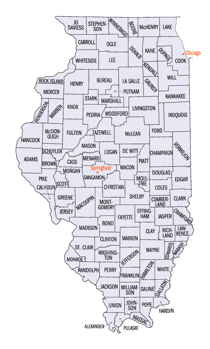Illinois Counties
There are one hundred and two counties in Illinois. St. Clair County was the first county established in what is today Illinois. Most counties in Illinois were named after early American leaders, especially of the American Revolutionary War, as well as soldiers from the Battle of Tippecanoe and the War of 1812.Gallatin County, Illinois
Gallatin County Education, Geography, and History
Gallatin County is a county located in the state of Illinois. According to the 2010 census, it has a
population of 5,589, making it
the fifth-least populous county in Illinois. Gallatin County was
created on September 14, 1812. The county
seat is Shawneetown. The county is named
for Albert Gallatin (1761-1849), fourth and longest-serving United
States Secretary of the Treasury.
Being located at the mouth of the Wabash River, Gallatin County, along with neighboring Posey County, Indiana, and Union County, Kentucky form
the tri-point of the Illinois-Indiana-Kentucky Tri-State Area.
Etymology - Origin of Gallatin County Name
The county is named for Albert Gallatin, financier and member of Congress from Pennsylvania.
Demographics:
County QuickFacts: CensusBureau Quick Facts
Gallatin County History
Gallatin County was created on September 14, 1812 (By Proclamation, Territorial Record of Illinois, p. 26) and was
formed from Randolph County. Present area, or parts of it, formerly included in: Randolph County (1801-1812) and Knox,
Northwest Territory (1790-1809).
The County was named for Albert Gallatin, a statesman and financier, Representative in Congress from Pennsylvania,
Secretary of the Treasury of the United States, and Minister to France and England. The County Seat is Shawneetown .
Prior County Seats was Shawneetown (1812-1827), Equality (1827-1848) and Shawneetown (1848-Present).
Near the end of the Revolutionary War, grants for land from the King of England were given and Virginia claimed the Illinois Territory. In 1787, Congress formed the Northwest Territory which included Gallatin County. It was divided many times after. April 27,1790, St. Clair along with Gallatin, were among the first counties. After being divided again, Gallatin finally came into its own Sept. 14,1812, appointing Shawneetown as the Seat of Justice. At this time, Gallatin county consisted of 1/4 of the Southern part of the state of Illinois. It still covered quite a bit of land.
Gallatin was named after Albert Gallatin, Secretary of Treasurer under President's Jefferson and Madison.
Early history of Gallatin was more centered on the Salt Licks of the Saline River. Evidence of the use of salt was found in the bones and teeth of prehistoric animals that ate the salt at the Half Moon Lick. The lick is in the shape of a horse shoe and is about 300 ft. at its widest part. Over centuries it's been licked down from animals. Indians made salt at the Half Moon and Lower Lick. The French took over and made salt here also until the English took over in 1763.
When the White man took over, Salt production changed significantly. Even more so when Slavery was sanctioned within the tract of land reserved for the Salt Works by the 1807 Indentured Law.Soon the town Equality began to grow and the 2 towns began to compete for attention as well as the County Seat. This angered people to the point of an election in 1852 where the majority vote was for Shawneetown being the County Seat.
The first known settler was Michael Sprinkle. He built a log cabin at the site of Shawneetown in 1800 and was a blacksmith and a gunsmith. He used his cabin as a trading post for the Indians and a distribution point for settlers in the 4 states.
Alexander Wilson started the 1st ferry around 1802 in Shawneetown. A fort was built for defense against the Indians in 1810. In 1816, John Marshall received a charter for the 1st Bank in Illinois to be built in Shawneetown. The 1st County Court was held by the Hon. John C. Slocumin in May, 1813. The 1st Newspaper was published by Henry May, 1818. Early settlers of Gallatin before 1815, are as follows: John Buck Michael Sprinkle, William Ellis, Alexander Wilson, John Marshall, Jacob Bargir, John Choisser, Jeptha Hardin, Joseph Logsdon, Robert Peoples, and Ephraim Hubbard.
Famous people that are apart of Gallatin's History are as follows: Marquis de Lafayette, Abraham Lincoln, Stephan A
Douglas, Peter Cartwright, John Logan, James Wilson, Michael K. Lawler,and Thomas Posey.
source: History and Families 1812-1988 Gallatin County, Illinois Turner Publishing Co.,Publishers of America's
History
Geography: Land and Water
As reported by the Census Bureau, the county has a total area of 328 square miles (851 km2), of which, 324
square miles (838 km2) of it is land and 5 square miles (12 km2) of it (1.43%) is water.
Gallatin county is located in south Illinois.
The Wabash and Ohio rivers join in the northeastern part of the county. The Saline River is a major drainage in the
county, and it feeds into the Ohio River.
Neighboring Counties
Bordering counties are as follows:
- North: White County
- Northeast: Posey County, Ind.
- Southeast: Union County, Ky.
- South: Hardin County
- West: Saline County
- Northwest: Hamilton County
Education







